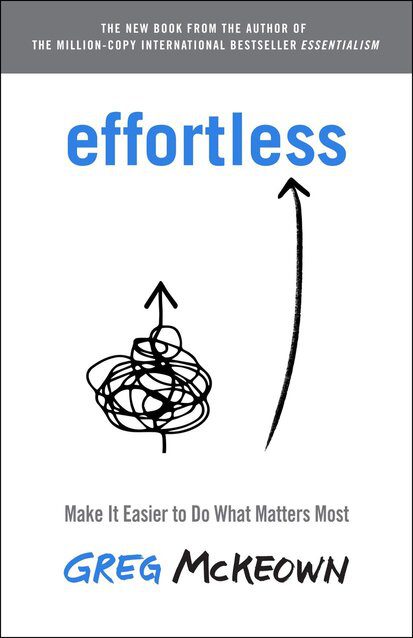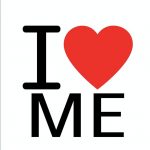Essentialism by Greg McKeown is one of my favorite productivity books, which explored living by design, not by default. The book goes in-depth on how to relentlessly pursue less and concentrate on what really matters. Effortless offers actionable advice for making the most essential activities the easiest ones, so you can achieve the results you want, without burning out.
Essentialism was about doing the right things; Effortless is about doing them in the right way.
Effortless
It’s about a whole new way to work and live. A way to achieve more with ease—to achieve more because you are at ease. A way to lighten life’s inevitable burdens, and get the right results without burning out.
The Book is divided into three sections:
- Part I reintroduces you to your Effortless State.
- Part II shows how to take Effortless Action.
- Part III is about achieving Effortless Results.
The Effortless Way
There is an ebb and flow to life. Rhythms are in everything we do. There are times to push hard and times to rest and recuperate. But these days many of us are pushing harder and harder all the time. There is no cadence, only grinding effort.
We live in a time of great opportunity. But there is something about modern life that’s like trying to hike at high altitude. Our brains are foggy. The ground beneath our feet seems unsteady. The air is thin and it can feel surprisingly exhausting to make even an inch of progress. Perhaps it’s the endless fear and uncertainty about the future. Perhaps it’s the loneliness and isolation. Perhaps it’s financial worries or hardships. Perhaps it’s all the responsibilities, all the pressures that can suffocate us on a daily basis.
“Whatever the cause, the result is that we’re often working twice as hard only to achieve half as much.”

Effortless
We all want to do what matters. We want to get in shape, save for a home or for retirement, be fulfilled in our careers, and build closer relationships with people we work and live with. The problem isn’t a lack of motivation; if it were, we would all already be at our ideal weight, live within our means, have our dream job, and enjoy deep and meaningful relationships with all the people who matter most to us.
Motivation is not enough because it is a limited resource. To truly make progress on the things that matter, we need a whole new way to work and live.
“Instead of trying to get better results by pushing ever harder, we can make the most essential activities the easiest ones.”
Part I: Effortless State
When our brains are at full capacity, everything feels harder. Fatigue slows us down. Outdated assumptions and emotions make new information harder to process. The countless distractions of daily life make it difficult to see what matters clearly.
Part II: Effortless Action
Once we are in the Effortless State, it becomes easier to take Effortless Action. But we may still encounter complexity that makes it hard to start or advance an essential project. Perfectionism makes essential projects hard to start, self-doubt makes them hard to finish, and trying to do too much, too fast, makes it hard to sustain momentum.
Part III: Effortless Results
When we take Effortless Action, we make it easier to get the results we want.
There are two types of results: linear and residual.
Whenever your efforts yield a one-time benefit, you are getting a linear result. Every day you start from zero; if you don’t put in the effort today then you don’t get the result today. It’s a one-to-one ratio; the amount of effort you put in equals the results received. But what if those results could flow to us repeatedly, without further effort on our part?
With residual results you put in the effort once and reap the benefits again and again. Results flow to you while you are sleeping. Results flow to you when you are taking the day off. Residual results can be virtually infinite.
Effortless Action alone produces linear results. But when we apply Effortless Action to high-leverage activities, the return on our effort compounds, like interest on a savings account. This is how we produce residual results.
Producing a great result is good. Producing a great result with ease is better. Producing a great result with ease again and again is best.
Effortless Inversion
Effortless Inversion means looking at problems from the opposite perspective. It means asking, “What if this could be easy?” It means learning to solve problems from a state of focus, clarity, and calm. It means getting good at getting things done by putting in less effort.
There are two ways to achieve all the things that really matter. We can
(a) gain superhuman powers so we can do all the impossibly hard but worthwhile work or (b) get better at making the impossibly hard but worthwhile work easier.
Once we invert the question, even everyday tasks that seem too overwhelming to tackle become easier.
Create Habits with a Soul
Rituals are similar to habits in the sense that “when I do X, I also do Y.” But they are different from habits because of one key component: the psychological satisfaction you experience when you do them.
“Habits explain “what” you do, but rituals are about “how” you do it. Rituals make essential habits easier to sustain by infusing the habits with meaning. ”
Effortless State
The Effortless State is an experience many of us have had when we are physically rested, emotionally unburdened, and mentally energized. You are completely aware, alert, present, attentive, and focused on what’s important in this moment. You are able to focus on what matters most with ease.
INVERT
Instead of asking, “Why is this so hard?,” invert the question by asking, “What if this could be easy?”
Challenge the assumption that the “right” way is, inevitably, the harder one.
Make the impossible possible by finding an indirect approach.
When faced with work that feels overwhelming, ask, “How am I making this harder than it needs to be?
ENJOY
Pair the most essential activities with the most enjoyable ones.
Accept that work and play can co-exist.
Turn tedious tasks into meaningful rituals.
Allow laughter and fun to lighten more of your moments.
RELEASE
Let go of emotional burdens you don’t need to keep carrying.
Remember: When you focus on what you lack, you lose what you have. When you focus on what you have, you get what you lack.
Use this habit recipe: “Each time I complain I will say something I am thankful for.”
Relieve a grudge of its duties by asking, “What job have I hired this grudge to do?
REST
Discover the art of doing nothing.
Do not do more today than you can completely recover from by tomorrow.
Break down essential work into three sessions of no more than ninety minutes each.
Take an effortless nap.
NOTICE
Achieve a state of heightened awareness by harnessing the power of presence.
Train your brain to focus on the important and ignore the irrelevant.
To see others more clearly, set aside your opinions, advice, and judgment, and put their truth above your own.
Clear the clutter in your physical environment before clearing the clutter in your mind.
Effortless Action
Effortless Action means accomplishing more by trying less. You stop procrastinating and take the first obvious step. You arrive at the point of completion without overthinking. You make progress by pacing yourself rather than powering through. You overachieve without overexerting.
If you want to make something hard, indeed truly impossible, to complete, all you have to do is make the end goal as vague as possible. That’s because you cannot, by definition, complete a project without a clearly defined end point. You can spin your wheels working on it. You can tinker with it. You can (and likely will) abandon it. But to get an important project done it’s absolutely necessary to define what “done” looks like.
DEFINE
To get started on an essential project, first define what “done” looks like.
Establish clear conditions for completion, get there, then stop.
Take sixty seconds to focus on your desired outcome.
“Write a “Done for the Day” list. Limit it to items that would constitute meaningful progress.
START
Make the first action the most obvious one.
Break the first obvious action down into the tiniest, concrete step. Then name it.
Gain maximum learning from minimal viable effort.
Start with a ten-minute microburst of focused activity to boost motivation and energy.
SIMPLIFY
To simplify the process, don’t simplify the steps: simply remove them.
“Recognize that not everything requires you to go the extra mile.
Maximize the steps not taken.
Measure progress in the tiniest of increments.
PROGRESS
When you start a project, start with rubbish.
Adopt a “zero-draft” approach and just put some words, any words, on the page.
Fail cheaply: make learning-sized mistakes.
Protect your progress from the harsh critic in your head.
PACE
Set an effortless pace: slow is smooth, smooth is fast.
“Reject the false economy of “powering through.”
Create the right range: I will never do less than X, never more than Y.
Recognize that not all progress is created equal.
Effortless Results
You’ve continued to cultivate your Effortless State. You’ve started to take Effortless Action with clarity of objective, tiny, obvious first steps, and a consistent pace. You are achieving the results you want, more easily. But now you want those results to continue to flow to you, again and again, with as little additional effort as possible. You are ready to achieve Effortless Results.
LEARN
Learn principles, not just facts and methods.
Understand first principles deeply and then apply them again and again.
Stand on the shoulders of giants and leverage the best of what they know.
Develop unique knowledge, and it will open the door to perpetual opportunity.
LIFT
Use teaching as a lever to harness the strength of ten.
Achieve far-reaching impact by teaching others to teach.
“Live what you teach, and notice how much you learn.
Tell stories that are easily understood and repeated.
AUTOMATE
Free up space in your brain by automating as many essential tasks as possible.
Use checklists to get it right every time, without having to rely on memory.
Seek single choices that eliminate future decisions.
Take the high-tech path for the essential and the low-tech path for the nonessential.
TRUST
“Leverage trust as the engine oil of frictionless and high-functioning teams.
Make the right hire once, and it will continue to produce results again and again.
Follow the Three I’s Rule: hire people with integrity, intelligence, and initiative.
Design high-trust agreements to clarify results, roles, rules, resources, and rewards.
PREVENT
Don’t just manage the problem. Solve it before it happens.
Seek simple actions today that can prevent complications tomorrow.
Invest two minutes of effort once to end recurring frustrations.
Catch mistakes before they happen; measure twice, so you only have to cut once.
Reduce the Lag Indicator
It’s no secret that many essential activities that are not particularly joyful in the moment produce moments of joy later on. If you exercise and eat better, you will eventually be healthier and lose weight. If you read every day, you will eventually develop expertise. If you meditate regularly, you will eventually develop a greater sense of calm in your life. But these are all lag indicators—meaning, you experience the reward after the action has taken place, sometimes weeks, months, or years afterward.
But essential activities don’t have to be enjoyed only in retrospect. We can also experience joy in the activity itself. We simply reduce the lag time between the action and satisfaction by pairing the essential activity with a reward.
All the Best in your quest to get Better. Don’t Settle: Live with Passion.



2 Comments
Pingback: On Complaining. – Lanre Dahunsi
Pingback: 100 Books Reading Challenge 2021 – Lanre Dahunsi